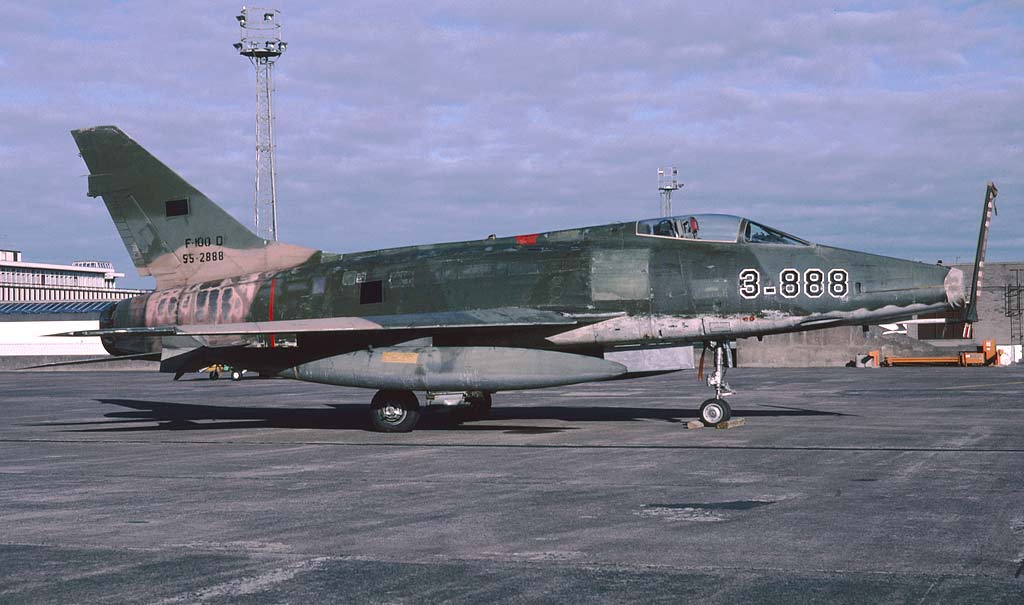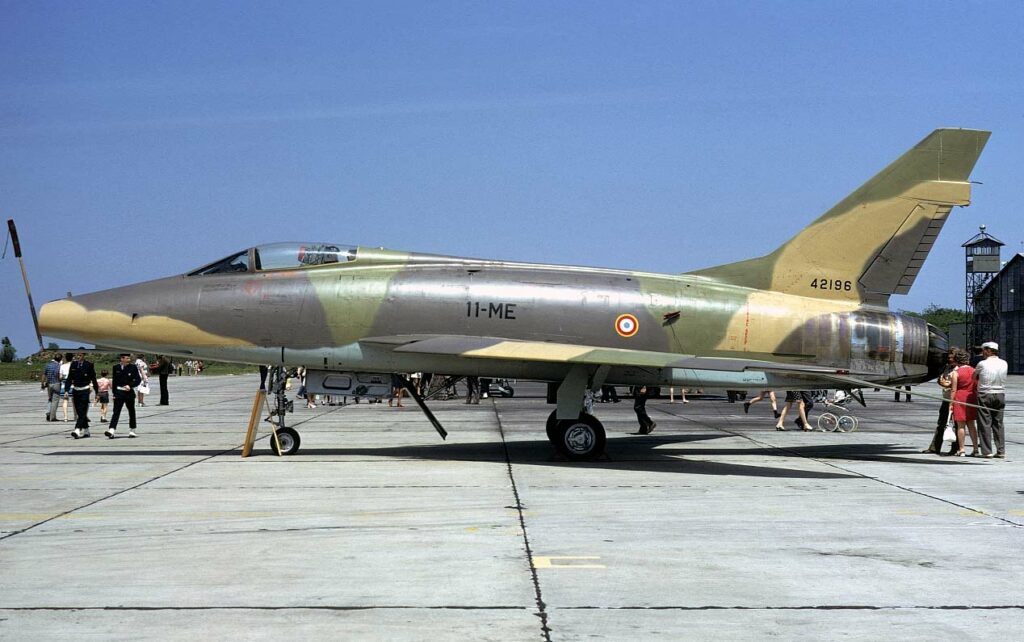North American F-100 Super Sabre was a supersonic jet fighter, Century Series member, USAF, first supersonic level flight, Pratt & Whitney engine, Mach 1.3 max speed.
In Brief
The North American F-100 Super Sabre, a member of the prestigious Century Series, was the USAF’s first supersonic jet fighter. Introduced in the 1950s, it represented a significant advancement in aviation technology. Equipped with a Pratt & Whitney J57-P-21/21A turbojet engine, the F-100 Super Sabre achieved a top speed of 864 mph (Mach 1.3), with a range of 1,733 NM and a service ceiling of 50,000 ft. Notable for its sleek design and powerful armament, including four 20 mm cannons, the aircraft was a leap forward in terms of speed and performance during the Cold War era. It played a critical role in various conflicts, most notably in the Vietnam War, serving in multiple roles ranging from air superiority to ground-attack missions.
The North American F-100 Super Sabre stands as a landmark in military aviation history, symbolizing the advent of supersonic jet fighters. This article provides an in-depth analysis of the F-100’s development, design, performance, variants, and military use.

History of the Development of the North American F-100 Super Sabre
During the early 1950s, as the Cold War escalated, there was a pressing need for advanced military aircraft capable of supersonic flight. The F-100 was developed to meet this demand, building on the success of its predecessor, the F-86 Sabre. North American Aviation launched the F-100 project in November 1951, with the USAF placing an order for prototypes and additional F-100As shortly after. The first prototype, the YF-100A, took flight on May 25, 1953, achieving supersonic speed in level flight, a first for a jet. The development faced challenges, including design modifications, particularly in armament and performance enhancements. The F-100 officially entered service with the USAF in September 1954, marking a new era in air combat capabilities.
Design of the North American F-100 Super Sabre
The F-100 boasted a sleek, aerodynamic design with a swept-wing configuration, enhancing its high-speed performance. It measured 50 feet in length (57′ 2″ for the F-100F variant), with a wingspan of 38 ft. 9 in., and a height of 16 ft. 3 in. The empty weight was around 21,000 lb, increasing to a maximum takeoff weight of 34,832 lb. The design incorporated a Pratt & Whitney J-57-P-21/21A engine, capable of delivering 10,200 lb of thrust in military power and 16,000 lb with afterburner. This design enabled the aircraft to reach a maximum speed of 864 mph (Mach 1.3), a range of 1,733 NM, and a service ceiling of 50,000 ft. The aircraft was armed with four 20 mm cannons, demonstrating formidable firepower.
Performance of the North American F-100 Super Sabre
The F-100’s performance was groundbreaking at its time. The F-100C variant, equipped with the powerful P&W J57-P-21 turbojet, achieved a maximum speed of 820 mph at altitude, with a service ceiling of 50,000 feet and a range of approximately 575 miles without drop tanks. The aircraft set the world’s first sustained Mach 1 speed record of 822.135 mph in 1955. Its design, particularly the extended wingspan and increased fuel capacity in later models like the F-100D, enhanced its handling and operational range. These performance metrics made the F-100 a formidable aircraft compared to its contemporaries.
Variants of the North American F-100 Super Sabre
The F-100 series saw several variants, each with specific enhancements. The F-100A was the initial version, setting the foundation for future models. The F-100C followed, featuring increased loaded weight and engine power, with the Pratt & Whitney J57-P-21 engine. The F-100D, the most produced variant with 1,274 units, was a dedicated fighter-bomber with key features like in-flight refueling capability, ECM equipment, and an enlarged wing and tail surfaces. The F-100F was introduced as a two-seat trainer to address the high accident rates with the F-100, later finding its role in the “Wild Weasel” anti-radar missions.

Military use and combat of the North American F-100 Super Sabre
The North American F-100 Super Sabre, a significant figure in the annals of military aviation, played a pivotal role in various conflicts, particularly during the Cold War era. Its deployment and use in combat operations provide insights into the evolution of air warfare and the strategic thinking of the time.
Armament
The F-100 was renowned for its formidable armament. It was primarily equipped with four 20 mm Pontiac M39A1 Revolver cannons, capable of delivering devastating firepower. The aircraft’s hardpoints allowed it to carry a variety of air-to-ground munitions, including conventional bombs, rockets, and later, nuclear weapons. It was also capable of carrying the AIM-9 Sidewinder air-to-air missiles, enhancing its role in aerial combat.
Use in Conflicts
Vietnam War
The most notable combat use of the F-100 was in the Vietnam War. Initially deployed for air superiority missions, its role quickly expanded to include close air support and interdiction missions. The Super Sabre was the first U.S. Air Force fighter to engage in ground-attack missions in Vietnam. Its ability to deliver precise strikes made it an essential asset during operations like Rolling Thunder and Commando Hunt.
Other Conflicts
The F-100 also saw limited action in other conflicts, such as its involvement in the Taiwan Strait Crisis, where it served a deterrent role. It was also deployed in various NATO exercises, showcasing its capabilities in diverse operational environments.
Tactical Use and Effectiveness
The F-100’s speed and firepower made it a formidable aircraft in strike missions. Its versatility in both air-to-air and air-to-ground roles allowed it to adapt to various mission requirements. However, its effectiveness was sometimes hampered by its high-speed performance at low altitudes, demanding exceptional piloting skills.
Operations and Missions
In addition to combat missions, the F-100 participated in numerous operational roles including reconnaissance, electronic warfare, and training missions. The aircraft’s adaptability allowed it to excel in these varied roles, contributing significantly to its operational history.
Success and Limitations
While the F-100 was successful in many respects, it faced limitations. Its performance in dense anti-aircraft environments was challenging, leading to losses. However, its overall contribution to air operations during its service life was significant, particularly in demonstrating the importance of air superiority and precision striking in modern warfare.
Competing Aircraft
The F-100 was contemporaneous with several other notable fighter aircraft, including the Soviet MiG-17 and MiG-19. These aircraft were often its adversaries in the skies over Vietnam. In terms of Western designs, the F-104 Starfighter and the F-105 Thunderchief were among its peers, each with their unique strengths and roles.
International Sales
The F-100 was exported to several U.S. allies, including Denmark, France, Taiwan, and Turkey. These sales were part of the U.S. strategy to strengthen its allies’ air capabilities during the Cold War.
Current Status
As of my last update in April 2023, the F-100 is no longer in active military service. It was gradually phased out, starting in the late 1970s, with the advent of more advanced aircraft like the F-4 Phantom II and the F-16 Fighting Falcon. These newer aircraft offered superior performance, versatility, and technological advancements, rendering the F-100 obsolete.
The North American F-100 Super Sabre holds a distinguished place in military aviation history. Its deployment across various theaters of conflict, particularly in Vietnam, highlighted the evolving nature of air warfare and the strategic importance of air superiority and precision striking. Despite its eventual obsolescence and replacement by more advanced aircraft, the Super Sabre’s legacy lives on as a testament to the innovation and tactical thinking of its era. Its influence is evident in the design and operational philosophy of subsequent generations of fighter aircraft.
Back to the Fighter Jet section.